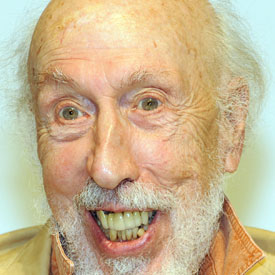‘Father of British pop art’ Richard Hamilton dies
He’s been called the father of British pop art, who influenced generations of artists. Tributes are being paid to Richard Hamilton, who has died aged 89.

The pioneer of British pop art, Richard Hamilton, has died at the age of 89. The Gagosian gallery, which represented him, said the art world had “lost one of its leading figures”.
Hamilton, who was born in London in 1922, didn’t come from an artistic background – far from it. His father was a driver for a car showroom. He first became interested in art at the age of ten; his talent was spotted when he entered a competition four years later – helping him to get a place at the Royal Academy School.
His studies were interrupted by wartime, by which time everything had changed, including the Academy – but Mr Hamilton went on to meet up with a number of like minded artists, architects and thinkers, while becoming exposed to a range of influences which would set the course for his future creativity.
Wicked, Sexy, Gimmicky, Glamorous, Big Business. Richard Hamilton
It was his 1955 collage, Just What Is It That Makes Today’s Homes So Different, So Appealing? that many credit as helping to instigate the British pop art movement. He even coined the term itself, in a 1957 letter to a pair of architects, discussing ideas for an exhibition.
“Pop Art is Popular (designed for a mass audience), Transient (short-term solution), Expendable (easily forgotten), Low Cost, Mass Produced, Young (aimed at youth), Wicked, Sexy, Gimmicky, Glamorous, Big Business,” he wrote.
Retrospectives
His work has been celebrated in retrospectives around the world, including two at the Tate Gallery in London in 1970 and 1992. He was preparing for another major touring exhibition at the Gagosian, just days before he died.
He also designed the cover for the Beatles’ White Album in 1968, the only cover not showing the Fab Four. Instead, the cover was almost completely white, adorned only with the band’s name and a grey number in the corner. According to an interview Mr Hamilton gave to the Observer last year, Paul Mc Cartney had been rather doubtful about the plan – “so I suggested that it would be fun to number each copy so that it would have the appearance of being a limited edition”.
Many of his best known pieces are instantly recognisable: his Swingeing London series from the sixties, his Shock and Awe inkjet print of Tony Blair, dressed as a cowboy with holster and boots.
Tributes from the art world
In art, it’s the mind, not the eye that should be active. Richard Hamilton
Among those paying tribute was the Tate director Nicholas Serota, who said Hamilton had “died as he would have wished”, working on his art. He praised what he called Hamilton’s “exquisite” works, which ranged his fascination with the consumer society against a trenchant critique of its excess, and his distrust of those he deemed to be from the political right.
The Gagosian gallery said he’d been at the vanguard of modern art.
“His influence on subsequent generations of artists continues to be immeasurable,” it said.
In his Observer interview last year, Hamilton said he had tried to free himself to do whatever he wanted, a stance inspired by his fellow artist Marcel Duchamp.
“Duchamp was truly iconoclastic,” he said. “This meant that he denied himself, that he knocked his own ideas out of the window. I thought: I should do the same – be careful, as he was, of repeating myself. In art, it’s the mind, not the eye that should be active.”
-
Latest news
-
Taylor Swift’s new break-up album breaks records3m

-
NHS trust fined £200K for failings that led to death of two mental health patients3m

-
Sunak vows to end UK ‘sick note culture’ with benefit reform3m

-
‘Loose talk about using nuclear weapons is irresponsible and unacceptable’, says head of UN’s nuclear watchdog3m

-
‘There wasn’t an Israeli attack on Iran,’ says former adviser to Iran’s nuclear negotiations team7m

-




